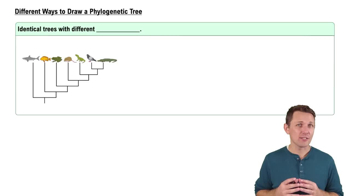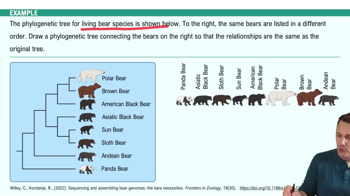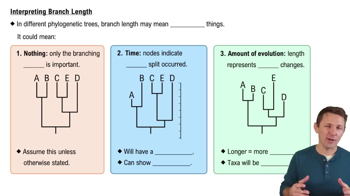Table of contents
- 1. Introduction to Biology2h 40m
- 2. Chemistry3h 40m
- 3. Water1h 26m
- 4. Biomolecules2h 23m
- 5. Cell Components2h 26m
- 6. The Membrane2h 31m
- 7. Energy and Metabolism2h 0m
- 8. Respiration2h 40m
- 9. Photosynthesis2h 49m
- 10. Cell Signaling59m
- 11. Cell Division2h 47m
- 12. Meiosis2h 0m
- 13. Mendelian Genetics4h 41m
- Introduction to Mendel's Experiments7m
- Genotype vs. Phenotype17m
- Punnett Squares13m
- Mendel's Experiments26m
- Mendel's Laws18m
- Monohybrid Crosses16m
- Test Crosses14m
- Dihybrid Crosses20m
- Punnett Square Probability26m
- Incomplete Dominance vs. Codominance20m
- Epistasis7m
- Non-Mendelian Genetics12m
- Pedigrees6m
- Autosomal Inheritance21m
- Sex-Linked Inheritance43m
- X-Inactivation9m
- 14. DNA Synthesis2h 27m
- 15. Gene Expression3h 20m
- 16. Regulation of Expression3h 31m
- Introduction to Regulation of Gene Expression13m
- Prokaryotic Gene Regulation via Operons27m
- The Lac Operon21m
- Glucose's Impact on Lac Operon25m
- The Trp Operon20m
- Review of the Lac Operon & Trp Operon11m
- Introduction to Eukaryotic Gene Regulation9m
- Eukaryotic Chromatin Modifications16m
- Eukaryotic Transcriptional Control22m
- Eukaryotic Post-Transcriptional Regulation28m
- Eukaryotic Post-Translational Regulation13m
- 17. Viruses37m
- 18. Biotechnology2h 58m
- 19. Genomics17m
- 20. Development1h 5m
- 21. Evolution3h 1m
- 22. Evolution of Populations3h 52m
- 23. Speciation1h 37m
- 24. History of Life on Earth2h 6m
- 25. Phylogeny2h 31m
- 26. Prokaryotes4h 59m
- 27. Protists1h 12m
- 28. Plants1h 22m
- 29. Fungi36m
- 30. Overview of Animals34m
- 31. Invertebrates1h 2m
- 32. Vertebrates50m
- 33. Plant Anatomy1h 3m
- 34. Vascular Plant Transport2m
- 35. Soil37m
- 36. Plant Reproduction47m
- 37. Plant Sensation and Response1h 9m
- 38. Animal Form and Function1h 19m
- 39. Digestive System10m
- 40. Circulatory System1h 57m
- 41. Immune System1h 12m
- 42. Osmoregulation and Excretion50m
- 43. Endocrine System4m
- 44. Animal Reproduction2m
- 45. Nervous System55m
- 46. Sensory Systems46m
- 47. Muscle Systems23m
- 48. Ecology3h 11m
- Introduction to Ecology20m
- Biogeography14m
- Earth's Climate Patterns50m
- Introduction to Terrestrial Biomes10m
- Terrestrial Biomes: Near Equator13m
- Terrestrial Biomes: Temperate Regions10m
- Terrestrial Biomes: Northern Regions15m
- Introduction to Aquatic Biomes27m
- Freshwater Aquatic Biomes14m
- Marine Aquatic Biomes13m
- 49. Animal Behavior28m
- 50. Population Ecology3h 41m
- Introduction to Population Ecology28m
- Population Sampling Methods23m
- Life History12m
- Population Demography17m
- Factors Limiting Population Growth14m
- Introduction to Population Growth Models22m
- Linear Population Growth6m
- Exponential Population Growth29m
- Logistic Population Growth32m
- r/K Selection10m
- The Human Population22m
- 51. Community Ecology2h 46m
- Introduction to Community Ecology2m
- Introduction to Community Interactions9m
- Community Interactions: Competition (-/-)38m
- Community Interactions: Exploitation (+/-)23m
- Community Interactions: Mutualism (+/+) & Commensalism (+/0)9m
- Community Structure35m
- Community Dynamics26m
- Geographic Impact on Communities21m
- 52. Ecosystems2h 36m
- 53. Conservation Biology24m
25. Phylogeny
Phylogeny
Problem 5e
Textbook Question
Textbook QuestionWhat important assumption does parsimony make when assessing which phylogenetic tree is most accurate? Why was parsimony misleading in the case of the astragalus during the evolution of artiodactyls?
 Verified step by step guidance
Verified step by step guidance1
Parsimony assumes that the phylogenetic tree that requires the fewest evolutionary changes is the most likely to be accurate. This principle is based on the idea that simpler explanations, requiring fewer changes, are preferable.
The assumption of parsimony can be misleading if convergent evolution or evolutionary reversals occur. These phenomena can lead to similar traits evolving independently in different lineages, which can be misinterpreted as shared ancestry.
In the case of the astragalus bone during the evolution of artiodactyls, parsimony was misleading because it failed to account for convergent evolution. The astragalus bone evolved similar morphological traits in different groups of artiodactyls independently.
The misleading result from using parsimony in this case led to incorrect assumptions about the relationships between different artiodactyl groups. It suggested a closer relationship between groups that independently evolved similar astragalus traits, rather than their true evolutionary relationships.
To avoid such issues, other methods like maximum likelihood or Bayesian inference, which consider the probability of evolutionary changes and can incorporate more complex models of evolution, are often used alongside or instead of parsimony.
Recommended similar problem, with video answer:
 Verified Solution
Verified SolutionThis video solution was recommended by our tutors as helpful for the problem above
Video duration:
5mPlay a video:
Was this helpful?
Key Concepts
Here are the essential concepts you must grasp in order to answer the question correctly.
Parsimony Principle
The parsimony principle in phylogenetics assumes that the simplest explanation, or the tree with the least number of evolutionary changes, is the most likely to be correct. This approach minimizes the complexity of evolutionary pathways by favoring trees that require fewer character state changes, thus providing a straightforward method for inferring relationships among species.
Recommended video:
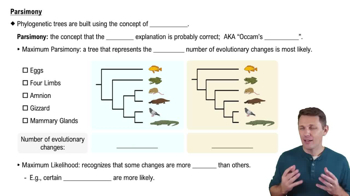
Parsimony
Phylogenetic Trees
Phylogenetic trees are graphical representations that depict the evolutionary relationships among various biological species based on their genetic or phenotypic characteristics. These trees illustrate how species diverged from common ancestors over time, allowing researchers to visualize and analyze evolutionary history and lineage.
Recommended video:

Building Phylogenetic Trees Example 2
Convergent Evolution
Convergent evolution occurs when unrelated species evolve similar traits or adaptations in response to similar environmental pressures, rather than from a common ancestor. This phenomenon can mislead phylogenetic analyses, such as in the case of the astragalus in artiodactyls, where similar adaptations may be incorrectly interpreted as evidence of close evolutionary relationships.
Recommended video:
Guided course
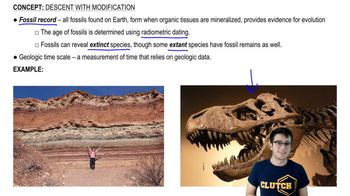
Convergent and Divergent Evolution

 7:10m
7:10mWatch next
Master Reading a Phylogenetic Tree with a bite sized video explanation from Bruce Bryan
Start learningRelated Videos
Related Practice









